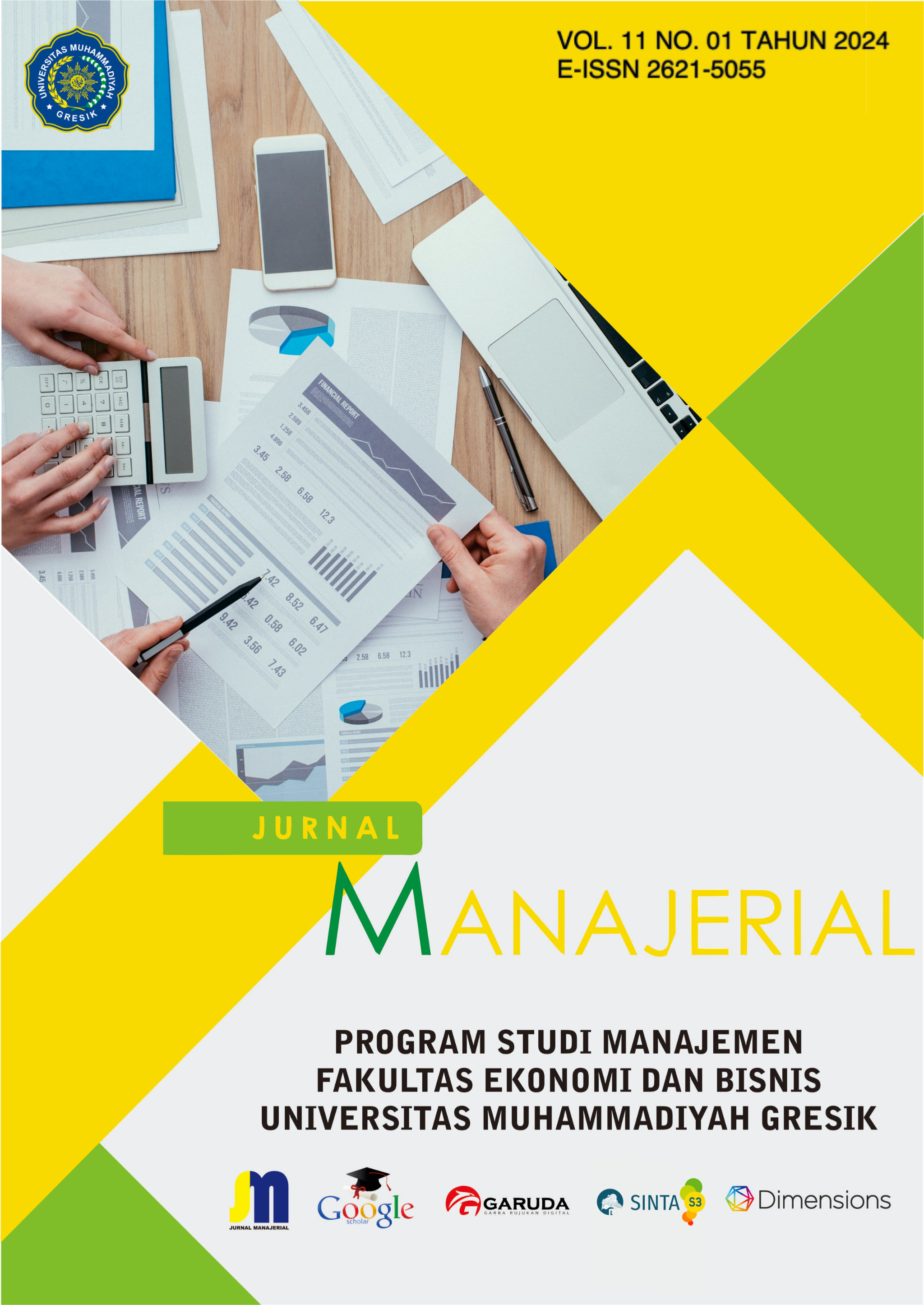The Mediating Role of Trust and its Relationship with the Perception of Convenience and Transparency on User Satisfaction of Electronic Procurement Services
DOI:
https://doi.org/10.30587/jurnalmanajerial.v11i01.5650Keywords:
LPSE, Convenience, Transparency, User, Trust, SatisfactionAbstract
Background – In the current 4.0 industrial revolution, the government is required to be able to create innovations including in public services based on information and communication technology. In addition, E-procurement is a form of innovation based on e-government which is almost entirely accomplished by making use of information and communication technology.
Aim – This study aims to determine the effect of perceived convenience and transparency on Electronic Procurement Services or LPSE user trust, the effect of ease, transparency and trust on LPSE user satisfaction, the impact of trust in mediating the effect of perceived convenience on LPSE user satisfaction, and the role of trust in mediating the effect of transparency on LPSE user satisfaction.
Design / Methodology / Approach – Respondents in this study were businessmen and consultants who had participated in tenders within the Ministry of Religion D. I. Yogyakarta as many as 180 respondents using the accidental sampling technique. A quantitative method of SEM and AMOS was applied in the study.
Findings – From the tested and collected data, the results show that ease and transparency perceptions affect positively and significantly on user trust. Furthermore, the feeling of convenience, transparency and trust bring a favorable and significant impact on user satisfaction. User satisfaction is unaffected by user perception through trust as an intervening variable.
Research implication – Transparency has no impact on customer satisfaction through trust as an intervening variable.
Limitations – Further research taking independent variables other than perceptions of convenience, transparency and trust.
References
Buttle, F., & Maklan, S. (2015). Customer Relationship Management: Concepts and technologies. Routledge.
Chang, C. C., & Hung, J. S. (2018). The Effects of Service Recovery and Relational Selling Behavior on Trust, Satisfaction, and Loyalty. International Journal of Bank Marketing, 36(7), 1437–1454. https://doi.org/10.1108/IJBM-07-2017-0160
Cheung, M. W. L. (2015). Meta-Analysis: A Structural Equation Modeling Approach. John Wiley & Sons Ltd.
Civelek, M. E. (2018). Essentials of Structural Equation Modeling. Zea Books.
Davis, F. D. (1989). Perceived Usefulness, Perceived Ease of Use, and User Acceptance of Information Technology. MIS Quarterly: Management Information Systems, 13(3), 319–340. https://doi.org/10.2307/249008
Dehghanpouri, H., Soltani, Z., & Rostamzadeh, R. (2020). The Impact of Trust, Privacy and Quality of Service on the Success of E-CRM: The Mediating Role of Customer Satisfaction. Journal of Business and Industrial Marketing, 35(11), 1831–1847. https://doi.org/10.1108/JBIM-07-2019-0325
Dt. Maani, K. (2009). Transparansi dan Akuntabilitas dalam Pelayananan Publik. Demokrasi, VIII(1), 48–61.
Duarte, P., Costa e Silva, S., & Ferreira, M. B. (2018). How Convenient is it? Delivering Online Shopping Convenience to Enhance Customer Satisfaction and Encourage e-WOM. Journal of Retailing and Consumer Services, 44, 161–169. https://doi.org/10.1016/j.jretconser.2018.06.007
Elbeltagi, I., & Agag, G. (2016). E-Retailing Ethics and its Impact on Customer Satisfaction and Repurchase Intention: A Cultural and Commitment-Trust Theory Perspective. Internet Research, 26(1), 288–310. https://doi.org/10.1108/IntR-10-2014-0244
Ferdinand, A. (2006). Structural Equation Modeling Dalam Penelitian Manajemen: Aplikasi Model-Model Rumit Dalam Penelitian Untuk Tesis Magister Dan Disertasi Doktor. Badan Penerbit Universitas Diponegoro.
Fiddin, F., & Dormos, E. (2019). Pengaruh Kemudahan dan Keyakinan Penggunaan Sistem Informasi Baru terhadap Minat Pemanfaatan Sistem Informasi Pada Organisasi Perangkat Daerah Provinsi Riau. Inovbiz: Jurnal Inovasi Bisnis, 7, 111–115. https://doi.org/10.35314/inovbiz.v7i2.1114
Ghozali, I. (2017). Model Persamaan Struktural Konsep dan Aplikasi dengan Program AMOS 24 Update Bayesian SEM. Badan Penerbit Universitas Diponegoro.
Harsojuwono, B. A., & Amata, I. W. (2020). Statistika Penelitian. Madani Media.
Hofmann, Y. E., & Strobel, M. (2020). Transparency Goes a Long Way: Information Transparency and Its Effect on Job Satisfaction and Turnover Intentions of the Professoriate. Journal of Business Economics, 90, 713–732. https://doi.org/10.1007/s11573-020-00984-0
In’nami, Y., & Koizumi, R. (2013). Structural Equation Modeling in Educational Research: A Primer. In Application of Structural Equation Modeling in Educational Research and Practice. Sense Publishers.
Johannes, & Widdy, F. (2018). Analisis Pengaruh Persepsi Kemudahan, Kemanfaatan, dan Kepercayaan terhadap Kepuasan Pengguna LPSE. Jurnal Digest Marketing, 3(1), 59–66.
Keni, K. (2020). How Perceived Usefulness and Perceived Ease of Use Affecting Intent to Repurchase? Jurnal Manajemen, XXIV(3), 481–496. https://doi.org/10.24912/jm.v24i3.680
Kline, R. B. (2016). Principles and Practice of Structural Equation Modeling. The Guilford Press.
Kotler, P., & Keller, K. L. (2012). Marketing Management. Pearson Education, Inc.
Kumar, A., Adlakaha, A., & Mukherjee, K. (2018). The Effect of Perceived Security and Grievance Redressal on Continuance Intention to Use M-Wallets in a Developing Country. International Journal of Bank Marketing, 36(7), 1170–1189. https://doi.org/10.1108/IJBM-04-2017-0077
Mashuri, M. A. (2016). Analisis Transparansi Layanan Pengadaan Barang dan Jasa Secara Elektronik (LPSE) Pada Kantor Komunikasi dan Informasi Kabupaten Maros Provinsi Sulawesi Selatan. Jurnal Dinamika Governance, 6(1), 13–22.
Medina, C., & Rufín, R. (2015). Transparency Policy and Students’ Satisfaction and Trust. Transforming Government : People , Process and Policy, 9(3), 309–323. https://doi.org/10.1108/TG-07-2014-0027
Meesala, A., & Paul, J. (2018). Service Quality, Consumer Satisfaction and Loyalty in hospitals: Thinking for the Future. Journal of Retailing and Consumer Services, 40, 261–269. https://doi.org/10.1016/j.jretconser.2016.10.011
Meileny, F., & Wijaksana, T. I. (2020). Pengaruh Persepsi Manfaat, Persepsi Kemudahan, Fitur Layanan dan Kepercayaan Terhadap Tingkat Kepuasan Pelanggan Linkaja di Indonesia. Jurnal Ecodemica: Jurnal Ekonomi, Manajemen, Dan Bisnis, 4(2), 1–9.
Mothersbaugh, D. L., & Hawkins, D. I. (2013). Consumer Behavior: Building Marketing Strategy. McGraw-Hill Education.
Nasim, A., & Romdhon, M. R. S. (2014). Pengaruh Transparansi Laporan Keuangan, Pengelolaan Zakat, dan Sikap Pengelola Terhadap Tingkat Kepercayaan Muzakki. Jurnal Riset Akuntansi Dan Keuangan, 2(3), 550–561. https://doi.org/10.17509/jrak.v2i3.6603
Naufaldi, I., & Tjokrosaputro, M. (2020). Pengaruh Perceived Ease of Use, Perceived Usefulness, dan Trust terhadap Intention to Use. Jurnal Manajerial Dan Kewirausahaan, 2(3), 715–722. https://doi.org/10.24912/jmk.v2i3.9584
Noor, J. (2015). Analisis Data Penelitian Ekonomi dan Manajemen. Grasindo.
Nurlukman, A. D. (2017). e-Procurement: Inovasi Penyelenggaraan Pemerintahan dalam Pengadaan Barang dan Jasa Berbasis e-Government di Indonesia. Journal of Government and Civil Society, 1(1), 81–93. https://doi.org/10.31000/jgcs.v1i1.264
Peppers, D., & Rogers, M. (2017). Managing Customer Experience and Relationships: A Strategic Framework. John Wiley & Sons, Inc.
Purba, M., Samsir, & Arifin, K. (2020). Pengaruh Persepsi Kemudahan Penggunaan, Persepsi Manfaat dan Kepercayaan terhadap Kepuasan dan Niat Menggunakan Kembali Aplikasi Ovo pada Mahasiswa Pascasarjana Universitas Riau. Jurnal Tepak Manajemen Bisnis, XII(1), 151–170.
Purba, N., Yahya, M., & Nurbaiti. (2021). Revolusi Industri 4.0 : Peran Teknologi dalam Eksistensi Penguasaan Bisnis dan Implementasinya. Jurnal Perilaku Dan Strategi Bisnis, 9(2), 91–98.
Putra, I. P. A. P. A., Sukaatmadja, I. P. G., & Giantari, I. G. A. K. (2020). Pengaruh Persepsi Kemudahan Penggunaan, Persepsi Risiko, Terhadap tepercayaan dan Niat Beli E-Ticket pada Situs Traveloka. Jurnal Ekonomi Dan Bisnis Universitas Udayana, 5(9), 3007–3030.
Rahman, M. A., Suwandi, M., & Hamid, A. (2016). Transparansi dan Akuntanbilitas Pengelolaan Keuangan Alokasi Dana Desa (ADD) Dalam Pencapaian Good Governance (Studi Empiris di Kecamatan Bontomarannu Kabupaten Gowa). Jurnal Minds: Manajemen Ide Dan Inspirasi, 3(2), 1–19. https://doi.org/10.24252/minds.v3i2.2929
Rismayadi, D. (2019). Akuntabilitas Dan Transparansi dalam Pelayanan Publik di Kecamatan Parigi Kabupaten Pangandaran. Dinamika: Jurnal Ilmiah Ilmu Administrasi Negara, 6(1), 8–14.
Sekaran, U., & Bougie, R. (2016). Research Methods For Business: A Skill Building Approach. John Wiley & Sons Ltd.
Setiawan, I. (2019). Pengembangan Teknologi Informasi dan Komunikasi dalam Menghadapi Era Revolusi Industri 4.0 di Kota Pontianak. Jurnal Teknologi Dan Komunikasi Pemerintahan, 1(1), 1–14.
Solomon, M. R. (2013). Consumer Behavior: Buying, Having, and Being. Pearson Education Limited.
Sugiyono. (2016). Penelitian Kuantitatif, Kualitatif, dan Kombinasi (Mix Methods). CV. Alfa Beta.
Susanto, A., Chang, Y., & Ha, Y. (2016). Determinants of Continuance Intention to Use the Smartphone Banking Services: An extension to the Expectation-Confirmation Model. Industrial Management and Data Systems, 116(3), 508–525. https://doi.org/10.1108/IMDS-05-2015-0195
Teo, T., Tsai, L. T., & Yang, C.-C. (2013). Applying Structural Equation Modeling (SEM) in Educational Research: An Introduction. In M. S. Khine (Ed.), Application of Structural Equation Modeling in Educational Research and Practice. Sense Publishers.
Tjahjono, H. K., Basuki, A. T., & Palupi, M. (2021). Aplikasi SEM dalam Studi Perilaku Organisasional. UPP STIM YKPN.
Umiyati, I., Syahroza, A., & Vera, D. (2016). Membangun Trust Terhadap Public E- Procurement Melalui Kualitas Sistem. Simposium Nasional Akuntansi XIX, Lampung, 2016, 1–35.
Walliman, N. (2011). Research Methods: The Basics. Routledge.
Waluyo, M. (2016). Mudah Cepat Tepat Penggunaan Tools Amos dalam Aplikasi (SEM). Penerbit UPN Veteran Jawa Timur.
Wilson, N., Keni, K., & Tan, P. H. P. (2021). The Role of Perceived Usefulness and Perceived Ease-of-Use toward Satisfaction and Trust which Influence Computer Consumers’ Loyalty in China. Gadjah Mada International Journal of Business, 23(3), 262–294. https://doi.org/10.22146/gamaijb.32106
Wirawan, V. (2020). Penerapan E-Government dalam Menyongsong Era Revolusi Industri 4.0 Kontemporer di Indonesia. Jurnal Penegakan Hukum Dan Keadilan, 1(1), 1–26. https://doi.org/10.18196/jphk.1101






























 P-ISSN: 2354-8592 __ E-ISSN: 2621-5055
P-ISSN: 2354-8592 __ E-ISSN: 2621-5055 
